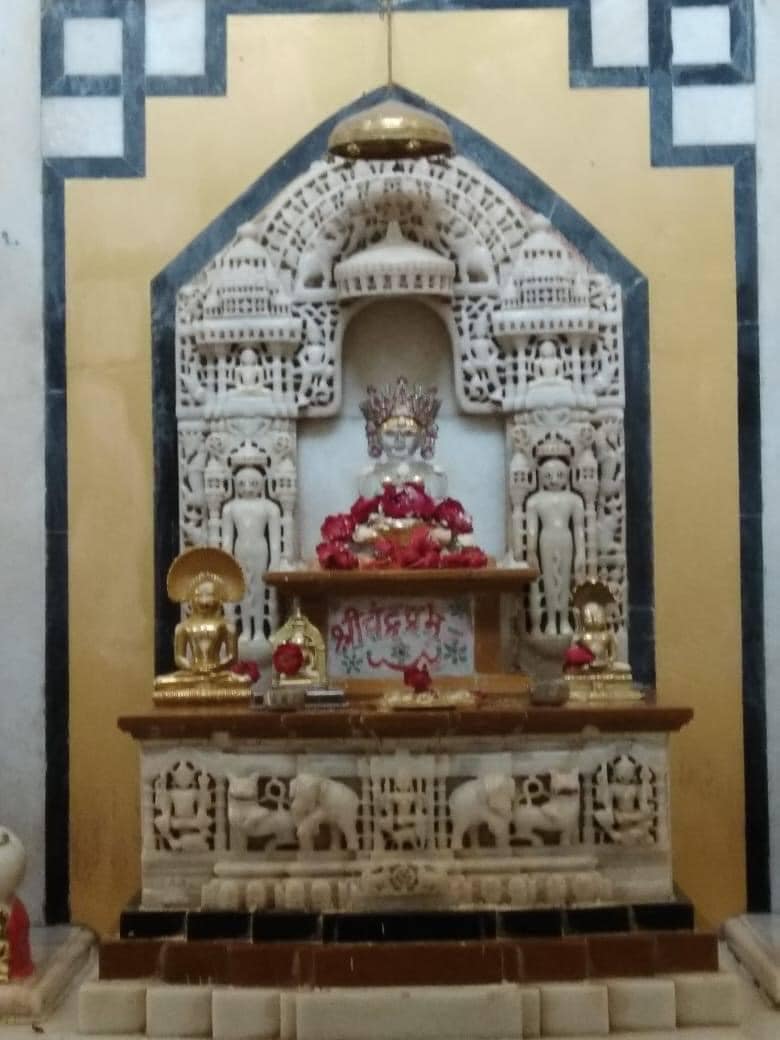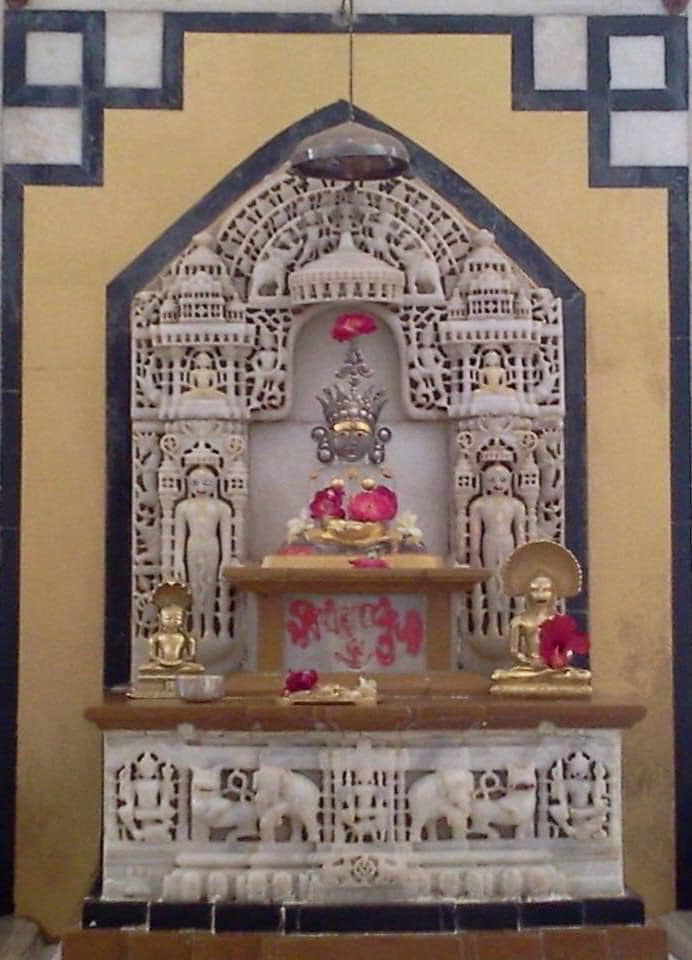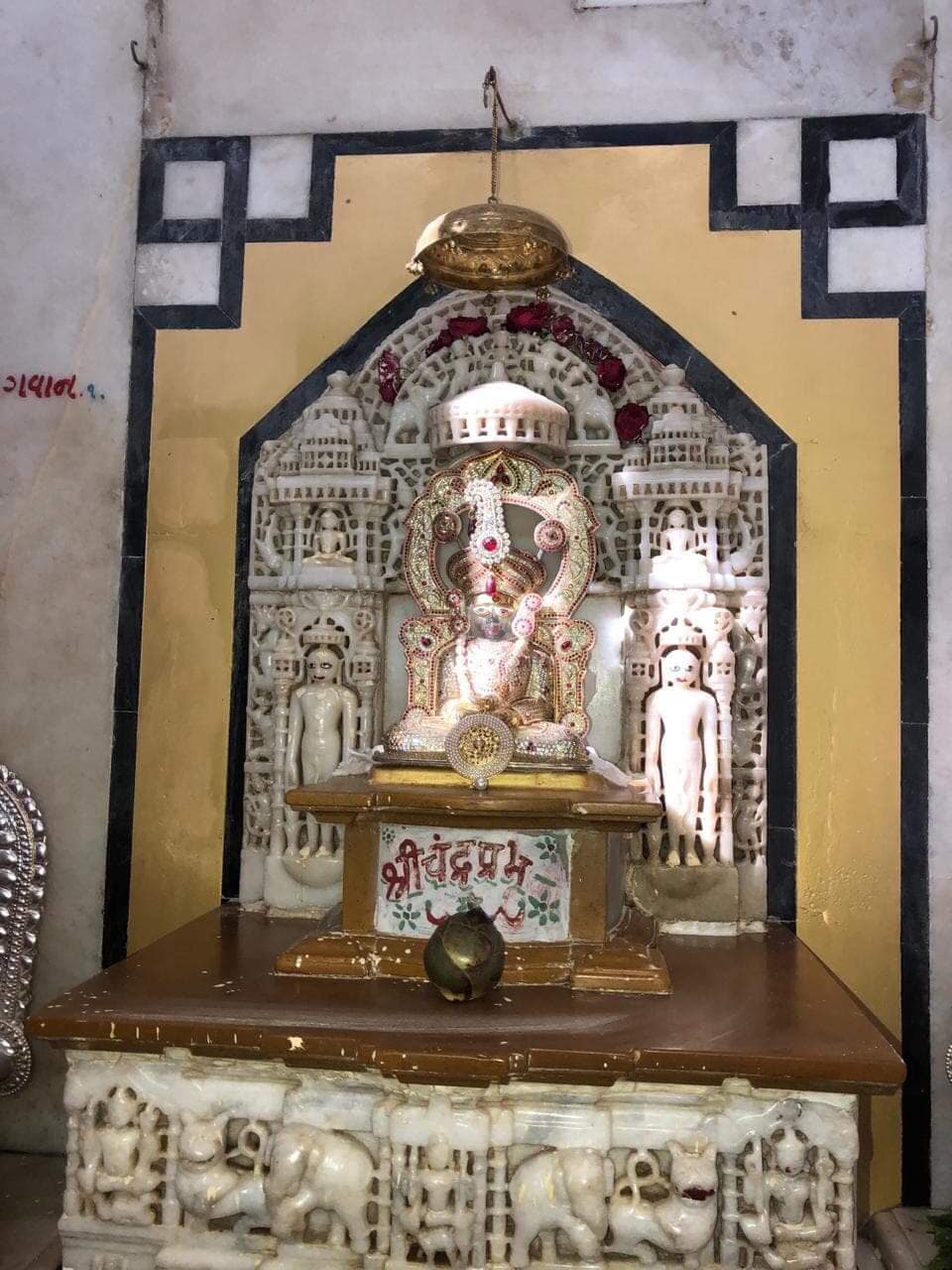



Shri Chandraprabh Swami Jain Derasar, Bhoyrapado, Lambi Oty, Khambhat, District - Anand (Gujarat)
Khambhat, Anand, GUJARAT
Temple History
Shwetamber Jain Temple in Khambhat, Anand Shree Chandra Prabha Swami Jinalaya BhoyaraPado - Khambhat The temple of Shree ChandraPrabha Swami is next to the temple of Shree Mallinathji in BhoyaraPado area of Khambhat. The temple is made of marble with a high summit. The idol of the presiding deity of Shree ChandraPrabha Swami is made of Quartz crystal. There is a write-up in the temple which informs that the idol was installed by Shree SomSundarSuriji of Tapagachha in Vikram Samvat 1496. Trambavati Tirthamala composed by Poet Rushabhdas in Vikram Samvat 1673 mentions the BhoyaraPada areas “Bhuira Pol”. There were three temples in this complex, from which the temple belonging to Shree ChandraPrabha Swami is found in the poem lines as below: ભુંઈરા કેરી પોલિ ભલેરી , ત્રણ પ્રાસાદઈ ભુંગલ ભેરી , કીરતિન કરું યન કેરી , હો શ્રી ચંદ્રપ્રભનઈ દેહરઈ દીસઈ , અઢાર બ્યંબ દેખી મન હીંસઈ , શાંતિનાથ જયન વીસઈ , હો. However, in the “Khambhaiti Tirthmala” composed by MatiSagarji in Vikram Samvat 1701, there is no mention of Shree Chandra Prabha Swami temple in Bhoyara Pado area. It is also possible that this temple might be referred to be in some other area by mistake. There is a reference of Shree Chandra Prabha temple in the Manek Chowk area near Shree Mallachar Pada area in Vikram Samvat 1701. As per the Vikram Samvat 1700’s list of Jain Temples of Khambhat, this temple has been referred under Number 68 as one of the 6 temples of Khambhat. અથ ભુંયરાપાડામાં દેહરાં - 6 66. શ્રી શાંતિનાથ 68. શ્રી ચંદ્રપ્રભ નામ 2 છે. In the Preface of JayTihuAna Stotra Granth (જયતિહુઅણ સ્તોત્ર ગ્રંથ), Temple of Shree Chandra Prabha Swami of Bhoyara Pada is listed in number 65 as below: 64. નવખંડા પારસનાથ અથવા ભુવન પરસનાથ 65. ચંદ્રપ્રભુજીનું In the Jain Shwetambar Directory of Vikram Samvat 1963, the temple has been mentioned as a terraced temple of Bhoyara Pada. It was also mentioned that there were 15 idols in the temple and that the building was a looking normal, like other buildings. In the Khambhat’s history and Khambhat Chaitya PariPaati of Vikram Samvat 1984, it is mentioned that Shree Chandra Prabha temple had 10 marble idols and 1 quartz crystal idol. The temple was taken care by PanaChand Nagindas and he used to stay nearby. On Magshar Sud 10th day of Vikram Samvat 1995 which was a Saturday dated 2nd December 1938, the idols were re-installed on 10.17am. There was a detailed article printed in Jain Satya Prakashan, Volume 5 of the 4th year on page 336 about this re-installation ceremony held in Bhoyara Pada area of Khambhat. It described the minute details and was exhaustive. An extract from that article is as below: " થોડા દિવસ પહેલાં ખંભાતના ભોંયરાપાડા નામના એક વિભાગમાં એક જીણોદ્ધાર કરાવેલ જિન મંદિરની પ્રતિષ્ઠા કરવામાં આવી. આ જિન મંદિર શ્રી ચંદ્રપ્રભ સ્વામી ભગવાનના મંદિર તરીકે ઓળખાય છે. આ પ્રતિષ્ઠા ઉત્સવ ત્યાંના ઓસવાલ શ્રી સંઘ તરફથી ઊજવવામાં આવ્યો હતો. અને શેઠ શ્રી ભોગીલાલ મગનલાલે રૂપિયા 1001 બોલી મૂળનાયક ભગવાન શ્રી ચંદ્રપ્રભુની સ્ફટિકની મૂર્તિની પ્રતિષ્ઠાનો લાભ લીધો હતો. આ પ્રસંગે વિજયઅમૃતસૂરિશ્વરજી મહારાજ આદિ ખંભાતમાં વિદ્યમાન હોવાથી તેમના પ્રેરણા અને સદુપદેશે લોકોને ખૂબ ઉત્સાહિત કર્યા હતા. આ પ્રતિષ્ઠામાં શ્રી ચંદ્રપ્રભુ સ્વામીનું જે બિંબ મૂળનાયક તરીકે પ્રતિષ્ઠિત કરવામાં આવ્યું હતું તેમાં અનેક પ્રકારની વિશેષતા હોવાને કારણે અહીં એનો ઉલ્લેખ કર્યો છે. એ વિશેષતાઓ આ છે. 1. આ મૂર્તિ સ્વચ્છ સ્ફટિક રત્નની હોવા સાથે લગભગ સાડા છ ઈંચ ઊંચી તેમજ પ્રમાણસર છે. 2. આ મૂર્તિ લગભગ 500 વર્ષ જૂની છે. 3. આની પ્રથમ પ્રતિષ્ઠા આચાર્ય શ્રી સોમસુંદરસૂરિજીના હાથે થઈ હતી. 4. આ ફરી પ્રતિષ્ઠા થઈ એ પહેલાં આ મૂર્તિ લગભગ 18 ઈંચ ઊંચા પિત્તલમય પરિકરમાં બિરાજમાન કરવામાં આવતી હતી. અને તે ચલ પ્રતિમા તરીકે પૂજાતી હતી. 5. સ્ફટિકમય મૂર્તિ ઉપર શિલાલેખ કોતરવો અશક્ય હોવાથી તેનો બધો ઈતિહાસ ભવિષ્યની પ્રજા માટે જળવાઈ રહે તે શુભ આશયથી એ મૂર્તિને લગતી બધી વિગત એ પિત્તલમય પરિકરની પાછળ લેખ રૂપે લખવામાં આવેલા છે. આ વિશેષતા ખરેખર અદ્વિતીય છે. આ સ્ફટિકમય મૂર્તિને લગતો લેખ પિત્તલમય પરિકરની ઉપર છે. આખો લેખ પડિમાત્રામાં લખાયેલ છે. અને 500 વર્ષનો ગાળો વીત્યા છતાં તેનો એક પણ અક્ષર ખંડિત થયો નથી. The summary of this article is that Sheth Govind who was son of Sheth Maaldev who was son of Sheth KarmaSinha, resident of Patan city and belonging to Shrimal sect, installed the current quartz crystal idol of Shree Chandra Prabha Swami along with a copper parikar on Jeth Sud 10th day of Vikram Samvat 1496 along with his family. And the installation was assisted by Shree SomSundarSuriji, heir of Shree DevSundarSuriji. This was a first instance in the Jain history, where a Quartz crystal idol was installed on a metal parikar and the entire history of this idol was permanently carved on the metal parikar. This article mentions the words “” which can also mean that this quartz crystal idol of Shree Chandra Prabha Swami could be older than Vikram Samvat 1496 and was without any parikar. And to keep the idol safe and secure, this metal parikar was installed. It has to be noted that this kind of an implementation is very unique and is not seen anywhere else. While doing the renovation work of the temple which was even before the metal parikar was installed, it is said that people found a copper plate measuring 6 or 7 square inches from under the idol’s seat. This metal plate had many Mantra letters and Ghantakarna Mantra inscribed on it. The period of Vikram Samvat 1400 to 1500s, ie., around the time of Shree SomSundarSuriji Maharaj was considered to be giving important to the usage of Mantra for various tasks. So, it might be possible that such a metal plate with Mantra could have been placed under the idol’s seat to benefit the Shree Sangh. This same metal plate was placed back under the idol’s seat, while re-installing the idol. Before placing the metal plate back, a picture was taken which can be used to study it further. A copy of this picture is with Acharya Shree VijayAmrutSuriji Maharaj. The amazing unique fact that the history of a quartz crystal idol was engraved on the metal parikar is similar to the uniqueness of finding a metal place with mantra undre an idol. This idol has many such specialities. This reinstallation of the idol was done in the morning 10.17am on Magshar Sud 10th day of Vikram Samvat 1995, Saturday dated 2nd December 1938. The write-up giving details about this re-installation was being put up on a wall in the temple. Acharya Shree VijayAmrutSuriji requested that the history of the quartz crystal idol of presiding deity of Shree Chandra Prabha Swami, which was engraved on the metal parikar should also be written exactly in this write-up. This was insisted to the local Jain people with the reason that this idol had been separated from the metal parikar and no-one knows what will happen to this metal parikar in future. And who would want the glorious history of this idol to be wiped away over time. In Jain Tirth SarvaSangrah of Vikram Samvat 2010, the temple of Shree Chandra Prabha Swami of Bhoyara Pada is described as a terraced temple. At that time there were 10 idols in the temple. The temple is said to have a stone inscription of Vikram Samvat 1496. At that time the temple was taken care by Sheth Dahyabhai Gandabhai and that the temple was termed to be in good condition. Today the temple is managed by Shree KusumChand Natwarlal as well as Shree AshwinKumar Chimanlal. They both stay in Bhoyara Pada. The main entrance gate of the temple has a beautiful arch. The gate from which we can enter into the main praying hall is made with carvings in BarShakh stone. The marble walls of the praying hall and its carvings is not like anywhere else. Main gate of the inner sanctum is also made with colorful carvings in BarShakh stone. The inner sanctum has 10 idols and a pair of 4 footprints carved on a marble plank. There is also a reference of re-installation in Vikram Samvat 1995. This reference is on a wall on the left side of the gate of the inner sanctum. In short, this temple is older than Vikram Samvat 1673.
Temple Category
Temple Timings
Morning Hours
Morning: 5:30 AM - 11:30 AM
Evening Hours
Evening: 5:30 PM - 8:30 PM
Plan Your Visit
How to Reach
By Train
Train: Khambhat Railway Station
By Air
Air: Vadodara Airport
By Road
Khambhat is well connected with roads
Location on Map
Nearby Temples in Anand
Shri Parasnath Digamber Jain Mandir, Karelibaug, V...
Karelibaug
Shri Pawandham Sankul Jain Upashray, Sukrutinagar,...
Diwalipura
Shri 1008 Parshvnath Digamber Jain Mandir, Sola R...
Ahmedabad
Shri 1008 Vasupujya Digamber Jain Mandir, Someshw...
Vesu
Explore More Temples




दान करे (Donate now)
हम पूजा, आरती, जीव दया, मंदिर निर्माण, एवं जरूरतमंदो को समय समय पर दान करते ह। आप हमसे जुड़कर इसका हिस्सा बन सकते ह।